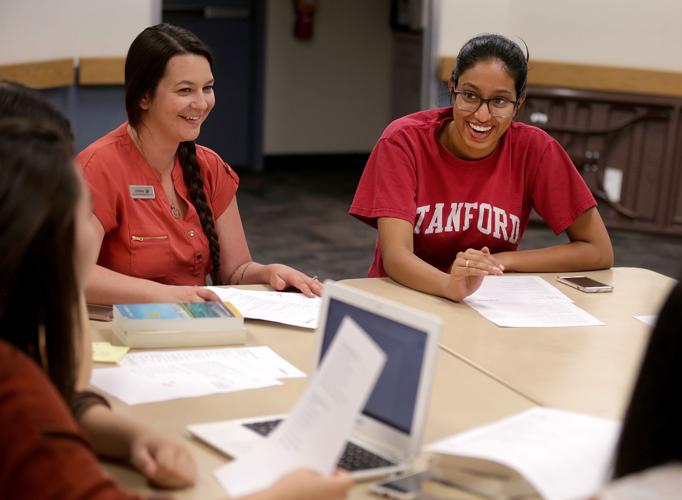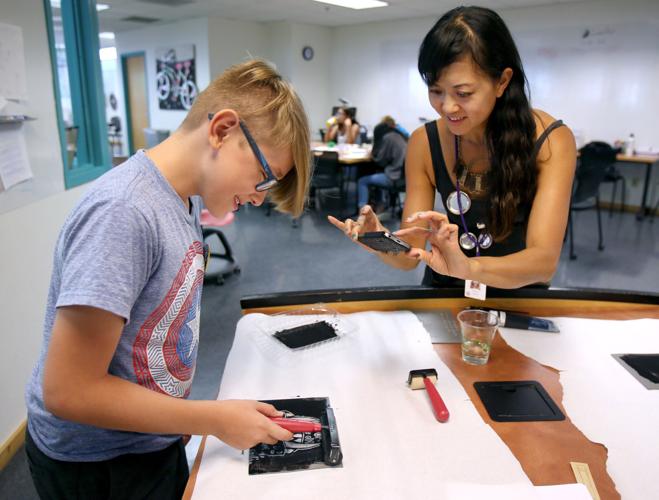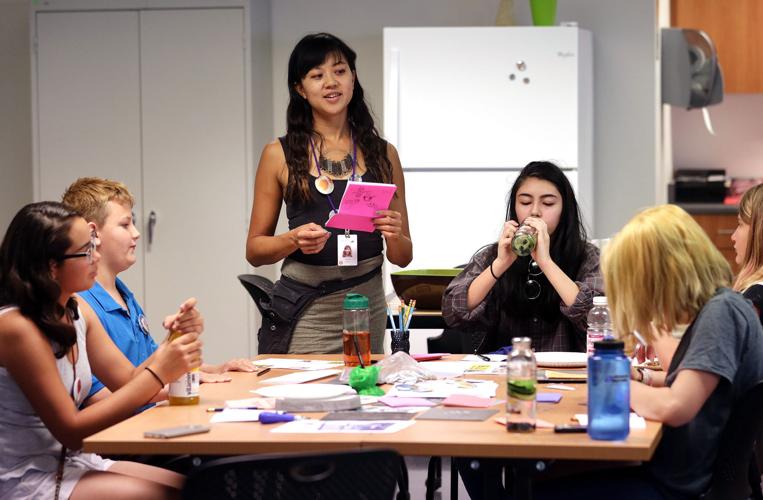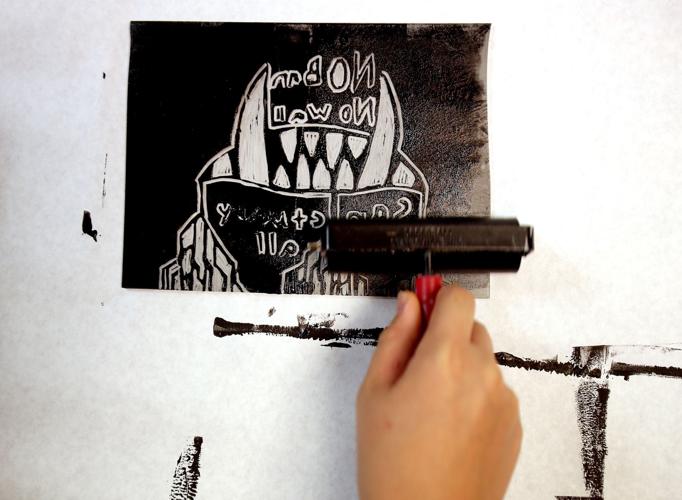The Dusenberry-River Library’s Teen Advisory Board members chose one word to describe their generation: “involved.”
On a recent Saturday morning, seven girls, ages 13 to 18, met with library associate Jusdina Nolin-Brown to talk about planning events and opportunities for community service.
“It’s really helped me get more involved in the community,” 17-year-old Nika Bogorad said about being on the board. “Even if it’s just the little parties we do here at the library, it’s really great seeing all the young kids come out and interact with them.”
Libraries across Pima County are engaging teens with new programs, providing space and opportunities focused on giving them real-world skills they can carry throughout their lives. The teen advisory boards are one way for teens to get involved in their communities.
Learning leadership
One event the teen board planned had a Harry Potter theme. They enjoyed seeing how happy the kids were while making wands and participating in the activities they had planned.
“We have to take responsibility and take leadership, and that can be really scary sometimes,” Bogorad said. “But it’s definitely a nice change of pace, especially if we might not get that exposure at school. We get a lot of team-building work done here.”
The teen board assists with library programming and finds out what it’s like to work in a library, said Holly Schaffer, Pima County Public Library community relations manager.
“They’re really brought into the fold of library life,” she said. “I think about myself as a teen when I was working at the movie theater. What I would have given to work at the library.”
Nolin-Brown started the Dusenberry-River board 2½ years ago. There are currently eight members, all girls, though boys are welcome to join. They meet two Saturdays a month to brainstorms future programs, including youth library-programming, community service and book reviews.
The board has volunteered at Chef for a Day with Ronald McDonald House Charities to prepare food for families in need, clothing drives for the Salvation Army, and Make Way for Books, which encourages early literacy.
They usually gain new members through word of mouth or by teens that already come to the library and pick up a flyer or want to volunteer.
Sense of community
“Most of them stay until they graduate, which has been a really cool aspect of it,” Nolin-Brown said. “They actually are very invested in this group and really enjoy it because they keep coming back.”
Nolin-Brown moved from Massachusetts to Tucson as a high school freshman and felt culture-shocked. She had a hard time making friends, but then she found the teen advisory board at the Geasa-Marana Library, which closed early this year.
“That was my first introduction to library world,” she said. “That teen advisory board got me a bottom-level-income job as a teenager in the library system, and I’ve stayed ever since. They can’t get rid of me.”
Nolin-Brown, who is now 26 with a master’s in information and library science, is not alone. A lot of the library’s permanent staff started out as teen volunteers, paid interns or on an advisory board and have stayed at the library while pursuing higher education.
There are currently five teen advisory boards, at the Dunsenberry-River, Nanini, Oro Valley, Quincie Douglas and Wheeler Taft Abbett Sr. libraries. Being on the board gives teens crucial life skills that are not always taught in school, such as leadership, project planning, perseverance and time management, Nolin-Brown said.
“That’s one of my biggest goals: What kind of soft skills do these teens need when they leave that they may not be getting already?” she said. “It’s just, in our own way, giving these teens every skill that we possibly can to help them succeed later in life.”
Exploring interests
Inside the 101 Space at Joel D. Valdez Main Library, a group of teen and preteen boys discuss their creations. One boy puts an action figure he calls “winter soldier dude” onto a scanner and the 3-D printer starts to go.
At another table sit two teenage girls. One proudly holds her 3-D creation in the palm of her hand, displaying a bold 2019—the year she will graduate from high school.
The projects are part of the Teen 365 programs for kids going into grades six through 12. These programs take place in all Pima County libraries. But only two, soon to be three, libraries have the 101 Space, designed for and by teenagers and dedicated to teen learning across a variety of topics.
“So you have, for example, a teen who is interested in robotics, but that teen doesn’t have the money to purchase the equipment to try it at home,” said Schaffer, the community relations manager. “We give teens the opportunity to play around with green screens, to play around with 3-D printers, to do sound engineering, to use coder robots.”
Teen events are categorized in the Teen 365 learning paths: make, seek, lead and tech. The “make” path includes things like crafts and screen printing. “Seek” includes a college-prep day or SAT prep. “Lead” programs teach leadership skills and personal responsibility. The “tech” path includes classes like Computer Game Design and Augmented and Virtual Reality.
When teens complete programs, they earn skill certificates that they can later put on a résumé.
Years of growth
The 101 Spaces, also at Oro Valley Library and soon to open at Valencia Library, have equipment that teens may not have access to elsewhere and also offer a safe and comfortable place where they can be themselves.
A paid youth design team of 24 teens spent two years designing the 101 Spaces. They surveyed 2,000 of their peers and held nine focus groups with youth organizations such as the Tucson Indian Center youth group and a refugee youth group. They pored through data and researched youth spaces in other libraries around the country.
“We looked at what the barriers were for teens,” said Kendra Davey, a family literacy coordinator working with the teen learning program. “We looked at the types of activities they were interested in.”
What they designed is a comfy, flexible space with movable booth seating, plenty of computers, outlets to charge electronics and an art wall.
The 101 Spaces were funded with a $100,000 grant from the John D. and Catherine T. MacArthur Foundation and the Institute of Museum and Library Services, and a $70,000 Library Services and Technology Act grant.
“It’s been this multiyear process of really expanding teen programming, refocusing it to be 21st-century skills,” Davey said. “As you’re learning 3-D printing, it’s not just about learning how to load the filament into the printer. It’s about how to problem-solve and how to work collaboratively with other people.”
Amelia Marsh was 17 when she joined the 101 Space youth design-team. She said the experience changed her life.
“We had a lot of say over the direction of the design process,” she said. “To have that experience of being respected at that age really gave me confidence to be able to take charge of different opportunities.”
Now 21, Marsh just received her bachelor’s from the University of Arizona in information science and continues to work on teen programming at the library. She developed a library program to teach coding to kids as young as 8 years old and led a coding seminar for girls.
“I would love to encourage any young people to come and check out the library and do a program,” Marsh said. “We have a community now, and we’re always trying to build that community.”








